1. Introduction
[1.1] In 1997, Espen Aarseth argued for the expanded study of adventure games—a computer game genre devoted to narrative experience—not as a bastardization of a literary form but as a literary form in itself: "The adventure game is an artistic genre of its own, a unique aesthetic field of possibilities, which must be judged on its own terms" (Aarseth 1997:107). He noted the roots of the genre as perhaps more in folk art than in commercial art: the story of the first adventure game "is a paradigm of collaborative authorship on the Net: one person gets an idea, writes a program, releases it (with the source code); somewhere else another person picks it up, improves it, adds new ideas, and rereleases it" (1997:99). This allows for the classification of this first adventure game, at least, as folk art created by authors building a narrative tradition through repurposing and expanding the text (1997:100). But even as Aarseth was writing, the origin of collaborative authorship had been superseded by commercial work—the dominant mind-set was no longer open source. As the adventure game form diminished commercially, many decried it as dead, but King's Quest designer Roberta Williams responded to the charge: "If you go back and look at where adventure games were and where they went, you can see that the adventure game is still there, it's just a different/better (depending on your particular point of view) experience playing them. The adventure game 'as we know it' just keeps evolving. It's still evolving" (White 2006). Today the commercial form of the adventure game little resembles the classic games of the era when Lucas Arts and Sierra were dominant, but the folk art tradition of the earlier form is also evolving separately in the hands of the fans.
[1.2] Just as the adventure game is being continually redefined and repurposed in the commercial arena, there are still authors continuing in this tradition of the game as folk art. These authors work in a manner that is collaborative and yet personal, in the tradition of adventure itself: they build games and tools, share those processes and their code, and expand upon the games and tools made within the community and outside in commercial projects. These authors are not merely continuing the tradition of the original games but are also adding their own ideas. The works of this tradition are what I call personal games—games created not by so-called independent or corporate collectives, but by individuals working within a collective to evolve this style of interactive narrative in their own images. Both the direct sequels and the reimaginings of classic-era commercial adventure games as well as the original storytelling of the personal game author can be better understood through the light of fan studies, as these games celebrate a very particular heritage of form and narrative best understood as an evolving digital folk art. The tools and products of this movement both replicate and expand upon the forms of the classic games of the 1980s and 1990s, when the genre was one of the dominant forms. The digital tradition of collaborative authorship is being extended by the community of personal game makers, who are building upon a tradition of the adventure game as folk art and narrative expression—some make deliberate references to other games and themes, and most adhere to or respond to the fundamental practices set down by the classic era.
2. Growing up in the classic era
[2.1] My generation was the first to grow up with video games as part of the stories that offered us a window into the transition to adulthood. The new form was immediately viewed with suspicion by those experienced enough to know better: we didn't know we were engaged in the formation of ourselves, we just thought we were shooting at demons. The shift to a world where it is possible to have the immersive experience of play in a fully realized interactive environment seemed to happen overnight, and the immediacy of the transition meant that those outside the virtual playground were not so ready to accept it into the cultural text as those born with the new toys. The battleground over gaming became a battle for identity. As an opportunity for the broadening of self, games did not begin in a promising fashion. They lacked both the imagery and immediacy of television and film and the depth of narrative of a book. Most of the games available in the early graphical form still didn't offer much of the details or imagery we've come to expect from modern games. Yet Marie-Laure Ryan describes how the games compensated for these elements by advertising an immersive experience: "Even in the 1980s, when computing power allowed only rudimentary graphics, developers promoted their products by promising a narrative experience that rivaled in its sensory richness the offerings of action movies" (Ryan 2006:182). The games born out of this focus on a narrative experience were called adventure games, games dedicated to telling a particular story around an embodied character. The addition of narrative to games built up quickly through the years, particularly once Nintendo begin to redefine the initial collections of pixels not as simple targets but as characters participating in battles of good and evil. The games offered the basic shapes and the virtual playground; we players provided the imagination to fill in the gaps. Actions taken by the players are necessary for the story to be fulfilled. Without a player, there is no story; the self is invested as part of the experience.
[2.2] Playing an adventure game is an experience of a narrative driven by someone else's rules. A player must accept and interact with the game environment to advance the designer's narrative, and the designer's intentions govern the possible story arcs. This creates an almost circular process of dependent meaning, where to understand any individual idea one must already understand the context in which that idea fits: a player in an adventure game is adapting to the imaginative structure of play. The more unfamiliar the ideas, the harder it is to gain understanding. Someone who encounters a game for the first time may have the same experience as someone encountering a fantasy story for the first time. Some of the dictionary definitions might already be familiar—for instance, the reader might have heard of dragons or wizards before—but that alone will not enable the reader to make sense of the nuances that experienced Dungeons & Dragons players see. An experienced reader of the genre gains satisfaction in seeing the rules and expectations of the genre both met and broken. Such a reader can process the idea of a particular depiction of unity among "good" and "evil" wizards for the sake of magic alone as a breaking of traditional expectations of good versus evil and can understand the writers' point about the importance of putting the preservation of knowledge above such conflict. An unfamiliar reader might look at the same words but see a very different picture, as they create backgrounds and learn from the narrative. The experiences the player brings to the game shape the story as it unfolds before them: no player, familiar or unfamiliar, is a passive vehicle for the author's narrative. The game author creates the boundaries for the story, but the player fleshes them out and brings them to life; code is stagnant without play.
[2.3] The earliest adventure games relied upon a system of bait and reward: the author set out the tasks, the player fulfilled them, and the author rewarded or punished the actions. The author's system of rewards did not necessarily make sense, nor have much correlation with reality. Success in the system required an understanding of what the author saw as necessary steps and solutions when designing the game. For instance, at the beginning of King's Quest I, the player is given three tasks to complete by an aging king. After receiving the quest to find three items, the player is set loose in a world where the simple decision to walk into the moat can lead to a quick death by a hungry moat monster. The player must master obscure rules and author decisions and overcome the author's barriers to help the knight he or she controls become king of the realm. Upon completion of the quests, the player is rewarded because the character is rewarded: the player learns that by problem solving, he or she can advance to victory. The player's investment in the game means the game does not need the same depth of narrative as we expect from a work of fiction, canonical or not: "A game does not need to tell stories that would provide suitable literary material to immerse the player in the fate of its fictional world, because the thrill of being in a world, of acting in it and of controlling its history, makes up for the intellectual challenge, the subtlety of plot, and the complexity of characterization that the best of literature has to offer" (Ryan 2006:195). Taking Ryan's concept further, the character and story do not need to be presented to the player because the player is holding several pieces of the puzzle. Adventure games are written to remove power from the author's hand. If a kingdom is to have multiple fates, the interactive narrative needs the player to control those outcomes, and those outcomes don't need to be developed to a level of narrative complexity—the player's actions provide that element.
[2.4] The thrill is the interactivity: the feeling that I as a player can shape the fate of the world. It doesn't matter that the story of King's Quest is incredibly contrived. A knight rescuing a kingdom, and later in the series becoming a king, then rescuing a princess…these are the archetypes of stories that don't require the player to engage in deep literary analysis. The connection I have with Sir Graham, King's Quest's knight errant, isn't because of his great depth of character: it's because of the melding of our characters and quests, trying out a different perspective and seeing the world through another's eyes. The games I played as a child have a particular hold on my mind because that was when I was just learning to stretch my mind in those directions: I remember the characters that were part of that initial experience of the other, someone beyond my initial realm of experiences. Playing a fully narrative game, ideally the player is not aware that the control is an illusion. The adventure games of my youth represented the most purely narrative form of game, a style that is occasionally decried as a dead genre despite the continual fascination with narrative games. I came to know the characters of these adventure games in a different sense than I know the characters of Shakespeare. I read about the escapades of the lovers caught in a magical forest, I imagined myself in their places; I became aware of new possibilities and ideas for love and fantasy. But Guybrush Threepwood, Indiana Jones, Sir Graham—those are characters whose lives I've played. The narratives of these characters may not offer the same depth as Shakespeare, but the experience of play allows for actually testing the possibilities and limitations the characters represent.
[2.5] While the adventure game as a commercial entity has moved away from its original roots, a thriving movement of independent game design keeps the traditional model of games about quirky heroes and strange stories alive. The 2004 personal game release Cirque de Zale, entirely designed by adventure game enthusiast Rebecca Clements, charmingly reverses the expectations of the genre: the main character, Zale, is pulled through a mystical portal to a fantasy land and offered the chance to rescue a princess and win the kingdom. Instead, he sensibly decides to settle down and start his own circus instead, and no amount of effort on the player's part can even save the princess—she's locked up and someone's thrown away the key. Players of the old King's Quest games who remember playing the hero and rescuing kingdom and princess have flocked to Zale's quest, and the designer describes her intention to evoke the tradition of Lucas Arts adventures: "I wanted people to get a real sense of nostalgia as they played it, which is exactly the kind of game I'd love to play" (Manos 2004). The Adventure Game Studio community, of which Rebecca Clements is a member, notes that as of March 2004, "The actual average age on the forums at present is 22 years old. There is, of course, a reason for the majority age group being young adults—people that are aged about 20 now would have played games like Monkey Island and King's Quest when they were children, and are now old enough to want to recreate the games" (Adventure Game Studio, n.d.) This self-description acknowledges the impact the classic games have had and continue to have on Adventure Game Studio productions, which are themselves created with an interface designed to allow others to expand upon the tradition. The type of production Rebecca engages in is still fan production, drawing upon the adventure game tradition and making specific reference to classics. It is furthermore designed to have a large appeal to fans of the original productions. Although it is not as obviously a work of fan production as the direct sequels I will examine more closely, it is characteristic of the folk art tradition of the personal game movement. None of these games can be considered separately from the classic heritage that guides the authors, the tools, and the community.
3. Revisiting the classic era
[3.1] Many of those adventure games listed by creators within the community as influences lie abandoned by their original creators and publishers. A fan cannot walk into a gaming store and find even a trace of most classic games beyond the occasional halfhearted release of a legacy collection. Both of the most oft-cited titans of the classic adventure game industry make the occasional nods to the fans of these games: Sierra recently released a collection of King's Quest games, while Lucas Arts last released a "classics collection" years ago. These collections are nothing more than a careless repackaging of the original: the King's Quest collection even includes the free software that allows the old game to work on a new system, but some configuration and fuss is still necessary and actual compliance of graphics and sound is far from guaranteed. Sierra did not make the effort to restructure the games for modern systems: instead they relied upon a program that emulates the operating system, a program that was standard when the classic era of adventure games was at its height. The program, Dos Box, as shown below, can allow games that relied on the old Soundblaster cards and limited memory to adapt to newer systems that would otherwise render such games unplayable (figure 1).

Figure 1. The DosBox command prompt interface.
[3.2] Playing old games on today's computers becomes a quest in itself: not only have advances in hardware led to incompatibility, but the games themselves are hard to acquire. Some gamers preserved the original floppy disks in collections, but floppy drives are no longer a standard component. Disintegration of old game materials has led to their virtual preservation: manuals are scanned, graphic novel introductions converted to digital forms, and so forth. Games themselves persist through similar illegal online distribution. As games persist under the bindings of copyright while the companies who created them have moved on to different systems, fans are taking ownership of these titles. These games retain an appeal and audience even in an era of gaming that has left two-dimensional environments behind in favor of increased graphical realism and elaborate gaming engines. Fans cite the failure of modern games to capture the old spirit of humor and story-driven play, and thus it is a common lament that adventure gaming in the classic sense is dead. Even the archives keeping the classic games available are often shut down for legal concerns: copyright law keeps the games under protection even though the commercial sale has disappeared. Unlike books, games rarely go back into print for a new run except in the occasional archive collection, in part because the genre of computer games is very forward-looking—there is always new technology on the horizon.
4. Assuming authorship
[4.1] Copyright law has proved to be no barrier preventing the fans from taking ownership of these games for recreation and expansion. Their efforts are distinguished from the more accepted practices of modders, or players who build new levels and content for games, by their intentions and product. Modders build on the original game, melding their efforts with those of the original developers and extending the content in a way that is of benefit to the original copyright holder: "multiplayer FPS [first-person-shooter] games are 'co-creative media'; neither developers nor player-creators can be solely responsible for production of the final assemblage regarded as 'the game,' it requires the input of both" (Morris 2003:8). The player-creators that Morris describes are active creators of new content in the same way as the authors of the adventure game community, but the first-person-shooter games in question have embraced the practice. The developers rely upon this created content to continue to expand playability options within their game and are secure in the knowledge that these mods are unplayable without ownership of the original copyrighted games. Fan creators of the classic adventure game movement can also be identified as cocreators, as they are in dialogue with the work of the original developers. The crucial distinction between fan authors in the adventure game community and modders in the first-person-shooter community is that the fan authors are not endorsed by those developers. Fan authorship co-opts material from the existing games without requiring the game itself. A game authored by a fan stands on its own and is playable as a complete structure. It is informed by the original, and may even be an exacting remake of the original, but it is developed separately. While the work of modders is tied to the original game by a web of interdependence, the games created by fan authors can even go so far as to replace the original game and render ownership of it irrelevant. The work of personal game creators, a subset of the fan authors, is less problematic in that such works tend to owe considerations of form or concept to the classics but not actual copyrightable characters, settings, or narratives.
[4.2] These fan authors use tools developed and distributed through online communities and made freely available for the purposes of creating and expanding the mechanics of the classic-era adventure games. These mechanics are based upon the subset of games most often revisited by fan authors: the Sierra and Lucas Arts games of the 1980s and 1990s. When these classic adventure games were created, game engines needed to be planned from scratch. Much was learned and derived from the text-based interactive fiction games that preceded graphical adventure games, but the ability to model an interactive graphical environment was then new. The focus on environment interaction required designers to take the traditional verbs of text interactions—push, pull, open, take, talk to, and so forth—and revise them to create avatar-based play. In 1987, Lucasfilm Games—which would soon be renamed Lucas Arts—released an animated adventure game titled Maniac Mansion, the first to use a gaming engine Lucas Arts would refine for most of their adventure game releases. This gaming engine was titled SCUMM, or "Script Creation Utility for Maniac Mansion." Designed by Aric Wilmunder and Ron Gilbert, the SCUMM gaming engine allows for the easy transfer of an adventure game to multiple platforms, meaning that the game could be played on the many different models of personal computers available at the time without as much difficulty in rewriting the code. The SCUMM interface has a unique characteristic: it places the traditional text-based verb commands for a game environment on a menu bar that takes up a third of the screen. This allows players to choose a verb such as "pick up" and enact that verb on an object from the game world, such as "pick up key." Thus, determining what actions are possible at any point in the game requires no guesswork. This engine was at the heart of many classic Lucas Arts games; the Sierra engine which developed in parallel offers similar properties.
[4.3] Decades later, creating a game that uses one of the classic systems relies upon what are essentially recreations of those classic engines. Some of the first players who wanted to create games along the lines of classic models developed tools for modeling with the traditional engines. Now many of these tools, which offer a graphical interface for adventure game development, are offered for free to other noncommercial game creators. The availability of these free tools creates a low barrier to entry for would-be creators: no real programming skill is required to make use of these systems. They are, like the games themselves, essentially point and click; even animating sprites is an easy task. Tools of this kind allow for fan production along the same lines as the revolution in fan filmmaking Jenkins previously chronicled: "Digital technologies have also enabled new forms of fan cultural production…fan filmmakers have used home computers to duplicate effects Lucasfilm had spent a fortune to achieve several decades earlier; many fan films create their own light saber or space battles" (2006:143–44). The online distribution of these tools is crucial to their influence. Would-be creators similarly moved by this particular style of game can easily locate both the tools and the specific tool sets inspired by interfaces of the era: even the most specific of interfaces are often available for easy reproduction, with fans posting tools for creating everything from the Lucas Arts SCUMM engine to the Gabriel Knight "talking heads" chat.
[4.4] Several different tools constructed by fans have been made available. Of these, the most popular is Adventure Game Studio, a tool for creating games in the classic Sierra style. The interface for Adventure Game Studio is shown below, here with the graphical interface overlay for managing dialogue options with nonplayer characters. The interface allows creators to manage all the standard elements of an adventure game without more than simple code (figure 2).

Figure 2. The menu system of Adventure Game Studio.
[4.5] Beyond providing a graphical interface for game production, Adventure Game Studio provides a community: would-be creators put their efforts online for their fellow enthusiasts to download and comment upon. The central hub of Adventure Game Studio is an active forum where authors find collaborators with different skill sets, seek out beta testers and advice on construction, and talk about games in general. Games with commercial intention are frowned upon in this setting. Creators are supposed to be motivated by pure love of the game, and perhaps by the desire to create a portfolio that will entice companies their way: the standards of this fan community dictate the importance of passion. Furthermore it is important to note that the creators of these games are often the players of other fans' titles: playing and creating these games is its own reward. In this, the fan authors have much in common with the modders of first-person shooters, whose work similarly rarely provides them with financial rewards even though they create content: "The precarious status of modding as a form of unpaid labour is veiled by the perception of modding as a leisure activity, or simply as an extension of play. This draws attention to the fact that in the entertainment industries, the relationship between work and play is changing, leading, as it were, to a hybrid form of 'playbour'" (Kücklich 2005). There is a purity ascribed to noncommercial intent that is itself illusory but appealing: the mystique of the fan author driven only by passion allows a purity of purpose to stand against the accusations of copyright infringement and intellectual property theft. In reality, there is also the promise of recognition from a community, as games created in this way can aspire to win awards given out by the community itself or to be reviewed by one of the Web sites devoted to the adventure game genre.
5. Fan remakes
[5.1] Devoted fans have made use of the available tools to reconstruct entire games, often with basic improvements to allow them to stand the test of time. These new versions are more playable than the old, as the games will run on more modern systems and can be made available through a simple downloadable executable. A number of classic games have undergone these fan treatments and been brought back to the attention of players new and old. Some are merely repackaged with enhanced graphics and interface; others are fully reworked, with fans trying to patch up holes in the original plot or provide music and voice acting where there was originally only static and text. Who is the true author of a fan remake? Certainly the original designer retains the credit for creating a world worth remastering. As for the fans, they are often hesitant to take any credit at all: the team responsible for many Sierra remakes as Tierra simply calls themselves the Anonymous Game Developers, although they have made their names public and their projects are far from forgotten. Yet anonymity is not a protection, nor does the removal of a name remove the fan from the murky territory of shared authorship. The fan author is engaging in a one-way dialogue with the works of the previous creators: the fan is remaking the classic game, and the original creator is now silent beyond their original production. This is perhaps best understood as a practice that extends Aarseth's consideration of the adventure game genre as folk art, as referenced earlier: works are put into the communal tradition, and new works emerge that continue and expand upon that tradition (1997:100). Who is the ultimate author of the work? All the creators involved in the practice. There need be no notion of one auteur, of one author working alone to create a masterpiece.
[5.2] One of the first great adventure games, Maniac Mansion, languishes in the Lucas Arts vault. It was last released as a playable application on a computer within its own sequel, Day of the Tentacle. Even that version was riddled with bugs: launching the game often crashed the system if it was too far advanced in hardware. A German enthusiast, known online as LucasFan, put in hours converting the game to Maniac Mansion Deluxe. LucasFan's Deluxe is a freely available and improved version of the original Maniac Mansion. LucasFan created the game using Adventure Game Studio, the aforementioned fan tool for modeling games in the style of the classics. He inputted the old environments and modeled anew the avatars and characters. Unlike the old version, which was constructed for the DOS operating system, this new version is playable on a range of computers and has in effect archived the Maniac Mansion experience for gamers present and future. While the Sierra fan coauthors faced legal consequences, LucasFan even earned an endorsement from the game's creator—if not from its copyright holders: "I think it's incredible," said Maniac Mansion cocreator David Fox. "When we first released these games, we figured people would be interested for two or three years, max. The fact people still care enough to put this kind of work into the games, it's amazing" (Ogles 2004). David Fox can be credited with recognizing his own work as part of a tradition of folk art. He accepts and invites the extension of his creation: to him, the story of Maniac Mansion did not end when his creative team shut the final door and put it in a box to ship.
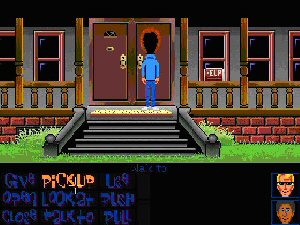
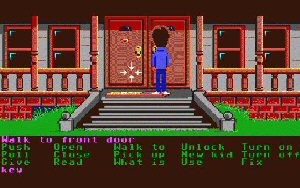
Figures 3 and 4. The fan-remade and original exterior of Maniac Mansion.
The two images here side by side (figures 3 and 4) show the improvements LucasFan made in his efforts. The image on the left is a screenshot from the new version, where LucasFan incorporated the interface from Maniac Mansion's sequel, Day of the Tentacle, and enhanced the graphics. He also included an easy interface for transitioning among the playable characters and enhanced the verb recognition. The image on the right is the original version: the spirit of the game is preserved while the quality is enhanced. The game now reaches the standard of design set by the Lucas Arts sequel, a quality that was not yet possible when Maniac Mansion was originally produced and the SCUMM engine that powers Lucas Arts classic games was only first developed.
[5.3] While fellow fans heaped their praises upon LucasFan's efforts, the copyright holders did not view it so kindly. In 2005, LucasFan made a dramatic disappearance from the Internet following rumors of a heated exchange between LucasFan and the attorneys responsible for Lucas Arts's cease-and-desist orders. At the time, LucasFan was rumored to be working on an Indiana Jones game in the spirit of the original Indiana Jones and the Fate of Atlantis adventure game, a project that might have brought him negative attention, given the status of the Indiana Jones license as still profitable for Lucas Arts. Details are difficult to confirm because the involved parties were mostly silent on the matter. The LucasFan Web site notes only, "Recent events have forced us to shut down our web appearance. We would like to thank all our fans and supporters who believed in us and our dreams" (LucasFan n.d.). The accompanying image recalls their Maniac Mansion remake with a tombstone set outside the famed mansion itself. The game, however, lives on, and the remake can still be downloaded through new sources that preserve the work. LucasFan as the author is unnecessary for the game's survival now that it is in the hands of a larger community (figure 5).
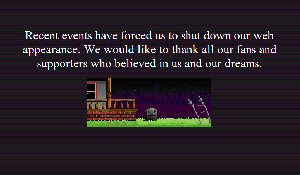
Figure 5. The final message from LucasFan.
[5.4] Sierra Games is at the center of even more active fan remastering. One team, Tierra (also known as Anonymous Game Developers), remade the first several games of King's Quest. The first remake, King's Quest I, was intended mainly to be a case of improved playability. The graphics were improved, the sound and dialogue increased, and the environments enhanced but generally unchanged from the spirit of the original game. This first remake was a testament to the possibilities of the efforts of the Tierra game and it paved the way for more dramatic undertakings. Released from 1984 to 1998, the games of the King's Quest series spanned over a decade and marked the most massive and successful series of adventure games. The later games were markedly different in technological sophistication and narrative advancement when compared to these early predecessors: even after Tierra's enhancements, the first game is dated by comparison. The most impressive aspect of the King's Quest I remake was the involvement of the original voice actor responsible for Sir Graham's voice acting in IV and V. As the actor explained in an interview, he was pleased to reprise the role: "For one, doing voices is just plain fun, and I especially enjoy doing them for games. For another, I think that the VGA remake is a great tribute to the original KQ series. And, lastly, because I was extremely flattered that they asked me to participate" (Wells n.d.). The remake is thus even more in sync with the original games with this audio connection through a voice that players of the sequels were already attached to. This gives legitimacy to the project it would otherwise lack: having the original voice of Sir Graham is a far cry from taking the best volunteer from the fan community itself.
[5.5] Tierra's next project was to take a dated prequel and utterly reshape its character. The team thus followed their initial effort with a remake of King's Quest II that was far more ambitious, intending to fill in gaps in the original plotline, increase character backgrounds, and generally overhaul the entire experience. The result was a game very different from the original project, even featuring a full voice-over when the original version had no spoken dialogue, only text boxes. Below is an image showing the graphic quality of this remake contrasted with a screenshot from the original version of the game (figures 6 and 7):

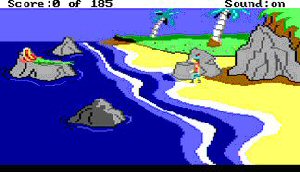
Figures 6 and 7. The fan-remade and original shores of King's Quest II.
The enhancement in this case is stunning: the game cannot easily be dismissed as a repackaging and is a full remake. In Tierra's hands, King's Quest II becomes a different game from a later decade. Tierra made use of much of what Sierra provided in sequels for imagery and interface but updated the game in their own style.
[5.6] A game that acts as a sequel or re-visioning of a classic adventure game is more likely to be played than an amateur effort without that grounding, although both works are acts of fandom relative to the genre itself. As one commentator noted after observing the fan-constructed tales around Star Trek:
[5.7] These types of stories, despite their disparate sociological nature, all share the mystical, cosmological and pedagogical dimensions of the original series, providing us with a well-formed response to Campbell's wish for consistently modern myths: by transforming themselves from a passive audience into active contributors to the mythos, these poachers have been able to adapt their myth of choice, retaining its mystical, cosmological and pedagogical functions even given the rapidly changing sociological climate. (Guaraldi 1997)
[5.8] The idea of writing inspired by other stories that have already gained a place in popular mythology is by no means limited to the kind of fan fiction found in such pursuits on the Web; examples of the same concept abound and often achieve great success. One example of this trend is Gregory Maguire's Wicked, which takes the rather one-dimensional villainess from The Wonderful Wizard of Oz and grants her a full biography, from birth to death. The devices Maguire employs are those of fan authorship, taking a classic work and adding a personal vision—creating new romantic attachments, giving a favorite character new motivation and spark, incorporating influences from more recent political and social concerns. Would the work be as successful if it had not been a work of fan fiction but had instead featured an unknown witch of no particular narrative heritage? It is impossible to be certain, but one thing is clear: as a work of fan fiction, it has recently been morphed into a well-received Broadway musical, a distinction few novels, and certainly few works of fan authors, are awarded.
[5.9] Many fan sequels follow similar lines of the fan remakes but with a new story. The Lucas Arts game Zak McKracken and the Alien Mindbenders has been repeatedly extended—LucasFan's first project was an extension of that game titled The New Adventures of Zak McKracken, pictured below (figure 8):
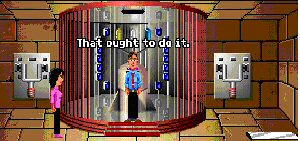
Figure 8. LucasFan's continued adventures of Zak McKracken.
[5.10] The game picked up where the first left off but showed its roots as an amateur effort: the puzzles and narrative were not yet fully developed. A range of other independent projects exist, some complete and some not, that have similar ambitions of extending the story. The King's Quest series also has a wealth of small projects surrounding it. Among them is King's Quest 2.5, a game intended to fill the gap in time between the second and third game in the series. That project followed the same style as the original games. A more divergent project was announced and summarily canceled by the Tierra team responsible for the King's Quest remakes. Titled Royal Quest, this project was intended as a parody of the series. The team released a few screenshots revealing their intentions and a preview described the vulgar and South Park–style humor of the parody (Wells n.d.) (figure 9).
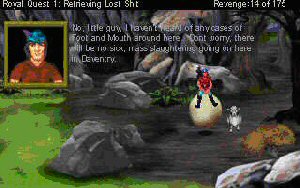
Figure 9. The abandoned Royal Quest parody.
[5.11] The project was abandoned with the explanation that the team intended to restore the standing of classic games and did not want to undermine their own efforts through releasing such a mean-spirited-seeming parody. The game has essentially disappeared from even Internet gossip—except, in the spirit of the fan remake, by the occasional person who claims that he or she will eventually produce their own version of the abandoned project. The rumor is kept alive by the same Internet communities that distribute the more faithful remakes, and perhaps it is from their midst that a new fan or a fan coauthor can emerge.
6. King's Quest IX: The Silver Lining
[6.1] Tierra's impressive efforts were not the end of fan efforts to reshape the King's Quest series. Another group of fans networking across the world decided to take on the ambitious project of creating a full sequel to the King's Quest games, this time using modern three-dimensional graphics and technology. Figure 10 below is one screenshot from that effort, which is now available only as a demo, as the full game has not yet been completed:
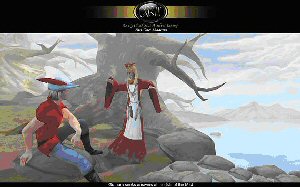
Figure 10. An early screenshot from the Silver Lining project.
[6.2] The project to create a sequel, now called The Silver Lining, was almost shut down by legal entanglements and the problem of copyright. Like fan fiction and fan movie projects, a fan-created game sequel is a violation of the original copyright holders' claim, but like those projects, such games often go unchallenged unless they reach a certain scale of attention. As the team now explains on their Web site, originally the copyright holders asked them to shut down: "On September 30, 2005, the team was asked to cease production by Vivendi Universal Inc., the owners of the King's Quest franchise. After weeks of negotiations and with the support of our fans, on November 29, 2005, Vivendi granted the team permission to legally continue production on the game" (Phoenix Online Studies n.d.a). The passion of the fans for the project—both those directly involved and those eagerly awaiting their chance to play the game—was the turning point in allowing the game production to continue. The only concession the fan author group had to make was removing the label of King's Quest from the project, so the game would not be confused with a legitimate creation of the original copyright holders.
[6.3] The Silver Lining stands out from the personal games movement in part because of the intense production values at work. Often personal games are associated with inferior production, limited graphics, and outdated technology. This is largely because they tend to be the works of an independent creator or small team operating with only their own money, no hope of compensation, and only their free time to devote to the project. Other King's Quest fan sequels adhere primarily to this more familiar personal game model, such as games like King's Quest 2.5, intended to fill small gaps within the series. The dated feel of most such independent projects hearkens back to the days before gaming was taken over by a corporate mentality, but this leads to assumptions about a lack of innovation within this world: to an outsider, it can look entirely stagnant, with graphics and interfaces literally frozen decades back in the realm of the two-dimensional side-scrolling game. These games innovate in other areas, such as story or presentation, but are by their very nature not at the forefront of technical innovation. They offer a chance for a fan voice to tell a story in this medium, but that voice is rarely heard outside the underground game community.
[6.4] No accusation can be made against The Silver Lining of falling under this stereotype: the graphics and technology in use are at the forefront of innovation. However, much of the origin of The Silver Lining matches the same humble beginnings as other independent efforts. There is no corporate powerhouse behind the The Silver Lining project, and no one on the creative team is being paid. When the final game is released, no one will make a profit: the game will be available for free, whereas a comparable effort by a corporation would be priced at $30 to $40 a copy. The development team, which calls itself Phoenix Online Studios, explains the driving motivations behind the team in terms of resurrecting the experience of the games they are so devoted to:
[6.5] The first is to bring the genre of adventure gaming back to its roots while giving it an overhaul of new elements such as the contemporary graphic format and more attention given to plot rather than random "pixel hunting"…[and] to create a community for our fellow adventure gamers where they can be given what they miss from the golden days and provide a space where they do not feel so isolated from the current trends of the gaming industry. (Phoenix Online Studios n.d.b)
[6.6] Phoenix Online Studios here acknowledges one of its primary motivations as fan authors: the pleasure of other fans moved by the values that these cocreators claim this particular style of game embodies.
7. Conclusion
[7.1] Like modders, fan fiction writers, or the creators of fan vids, the new cocreaters of these neoclassic adventure games are participants in a fusion of play and labor. They produce content without reimbursement for their time or efforts. That content is in turn made freely available, easily downloadable by fellow enthusiasts through communal hubs like that of the Adventure Game Studio Web site. Sometimes these releases are even in clear competition with the commercial endeavors of the primary creators, as with the King's Quest remakes and Sierra's rerelease of the series. The audience is small, and while authorship may have passed to the fans, ownership remains in the hands of the creators. Yet the fan cocreators persist and through their authorship continually recreate the worlds of their devotions through a practice of a still-evolving tradition of folk art gone digital. The tools of the trade, with their baseline interfaces and engines providing for the same style of interactions as the early games of the classic era, encourage both adherence to the standards of the genre as well as deviation and further expression through personal consideration of the potential points of departure of the adventure game experiences. Whether that authorship results in new personal games following original storylines or in so-called fan games emerging directly out of works of the classic era, these authors are participating in a postcommercial venue of production that encourages the proactive remix of cultural artifacts as part of the building of digital folk art.